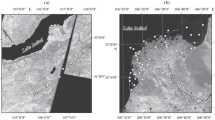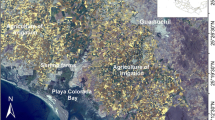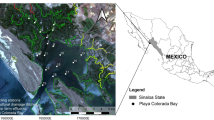Abstract
A simple model based on available Landsat imagery data was used in order to characterize the dynamics of a rainstorm-induced turbid plume into a semi-arid, medium-sized reservoir. Additionally, a set of empirical expressions based on mouth river conditions was employed to estimate the spatial extent of the turbid plume, as well as the influence of the wind on the spreading and resuspension of sediment. This predicted plume behavior was then confirmed by the imagery data. Overall, the main contribution of the paper is a unified procedure of different approaches that can be applied to forecast turbidity effects during muddy inflow events in aquatic systems where minor field-measured information is available. The approach may be also considered as an assisting tool to provide managers with the capacity to develop real-time strategies to monitor flood events.










Similar content being viewed by others
References
Alcantara E, Stech J, Lorenzzetti J, Bonnet M, Casamitjana X, Assireu A, Novo E (2010) Remote sensing of water surface temperature and heat flux over a tropical hydroelectric reservoir. Remote Sens Environ 114(11):2651–2665
CERC (1984) Coastal Engineering Research Center. Shore protection manual. Waterways Experiment Station, US Army Corps of Engineers
Chavez P (1996) Image-based atmospheric corrections revisited and improved. Photogramm Eng Remote Sens 62:1025–1036
Choubey V (1994) Monitoring water quality in reservoirs with IRS-1A-LISS-I. Water Resour Manag 8(2):121–136
Chung E, Hipsey M, Imberger J (2009) Modelling the propagation of turbid density inflows into a stratified lake: daecheong reservoir, Korea. J Environ Model Softw 24:1467–1482
Cohen W, Goward S (2004) Landsat’s role in ecological applications of remote sensing. Bioscience 54(6):535–545
Fernandez R, Lasso R, Furbatto C, Larrosa N (2010) “Modelación por la contaminación por fuentes difusas en la cuenca hídrica del embalse Los molinos” XXIV latinoamerican congress. Punta del Este, Uruguay
Florsheim J, Keller E, Best D (1991) Fluvial sediment transport in response to moderate storm flows following chaparral wildfire, southern California. Geol Soc Am Bull 103:504–511
Ford D, Johnson M (1983) An assessment of reservoir density currents and inflow processes. Technical report E-83-7, U.S. Army Corps of Engineering Waterways Experiment Station, Vicksburg
Gao B, Montes M, Davis C, Goetz A (2009) Atmospheric correction algorithms for hyperspectral remote sensing data of land and ocean. Remote Sens Environ 113(1):517–524
Garvine R (1995) A dynamical system for classifying buoyant coastal discharges. Cont Shelf Res 20:2067–2093
Giardino C (2010) Application of remote sensing in water resource management : the case study of lake Trasimeno, Italy. Water Resour Manag 24(14):3885–3899
Giardino C, Pepe M, Brivio P, Ghezzi P, Zilioli E (2001) Detecting chlorophyll, secchi disk depth and surface temperature in a sub-alpine lake using landsat imagery. Sci Total Environ 268(1–3):19–29
Han Z, Jin Y, Yun C (2006) Suspended sediment concentrations in the Yangtze River estuary retrieved from the CMODIS data. Int J Remote Sens 27(19):4329–4336
Hawley N, Lesht BM (1992) Sediment resuspension in Lake St Clair. Limnol Oceanogr 37(8):1720–1737. doi:10.4319/lo.1992.37.8.1720
Hebbert B, Imberger J, Loh I, Petterson J (1979) Collie River underflow into the Wellington Reservoir. J Hydraul Div ASCE 105:533–545
Hellweger F, Miller W, Oshodi K (2006) Mapping turbidity in the Charles River, Boston using a high resolution satellite. Environ Monit Assess 132(1–3):311–320
Herting A, Farmer T, Evans J (2004) Mapping of the evaporative loss from elephant butte reservoir using remote sensing and GIS technology. Technical report. States University (NMSU, CAGE), New Mexico
Hu C, Muller-Karger F, Andrefouet S, Carder K (2001) Atmospheric correction and cross-calibration of LANDSAT-7/ETM+ imagery over aquatic environments: a multiplatform approach using sea WiFS/MODIS. Remote Sens Environ 78(1–2):99–107
Huang C, Zhang Z, Yang L, Luylie B, Homer C (2002) MRLC 2000. Image Preprocessing Procedure, USGS
Imberger J, Patterson JC (1990) Physical lumnology. Adv Appl Mech 27:303–475
Jirka GH, Adams EE, Stolzenbach KD (1981) Buoyant surface jets. J Hydr Div 10711:1467–1487
Jones G, Nash D, Doneker L, Jirka H (2007) Buoyant surface discharge into water bodies. I: flow classification and prediction methodology. J Hydraul Eng 133:1010–1020
Kloiber S, Brezonik P, Olmanson L, Bauer M (2002) A procedure for regional lake water clarity assessment using Landsat multispectral data. Remote Sens Environ 82(1):38–47
Luettich RA Jr et al (1990) Dynamic behavior of suspended sediment concentrations in a hallow lake perturbed by episodic wind events. Limnol Oceanogr 35(5):1050–1067. doi:10.4319/lo.1990.35.5.1050
Mian M, Yanful E (2004) Analysis of wind-driven resuspension of metal mine sludge in a tailings pond. J Environ Eng Sci 3:119–135
Miller J, Yool S (2002) Mapping forest post-fire canopy consumption in several overstory types using multi-temporal Landsat TM and ETM data. Remote Sens Environ 82(2–3):481–496
Ostlund C, Flink P, Strombeck N, Pierson D, Lindell T (2001) Mapping of the water quality of lake Erken, Sweden, from imaging spectrometry and Landsat thematic mapper. Sci Total Environ 268(1–3):139–154
Ouaidrari H, Vermote E (1999) Operational atmospheric correction of Landsat data. Remote Sens Environ 70(1):4–15
Parker G, Toniolo H (2007) Note on the analysis of plunging of density flows. J Hydraul Eng 133(6):690–694
Pavelsky T, Smith L (2009) Remote sensing of suspended sediment concentration, flow velocity, and lake recharge in the Peace-Athabasca Delta, Canada. Water Resour Res 45:W11417. doi:10.1029/2008 WR007424
Peckham S (2008) A new method for estimating suspended sediment concentrations and deposition rates from satellite imagery based on the physics of plumes. Compt Rendus Geosci 34(10):1198–1222
Reneau SL, Katzman D, Kuyumjian GA, Lavine A, Malmon DV (2007) Sediment delivery after a wildfire. Geol Soc Am 35(2):151–154
Saville T (1954) The effect of Fetch width on wave generation. Journal Technical Memorandum, 70
Schmugge T, Kustas W, Ritchie J, Jackson T, Rango A (2002) Remote sensing in hydrology. Adv Water Resour 25(8–12):1367–1385
Shukla J, Misra A, Chandra P (2008) Modeling and analysis of the algal bloom in a lake caused by discharge of nutrients. Appl Math Comput 196(2):782–790
Smith V, Tilman G, Nekola J (1999) Eutrophication: impacts of excess nutrient inputs on freshwater, marine, and terrestrial ecosystems. Environ Pollut 100(1–3):176–196, Oxford, U. K
Song C, Woodcock C, Seto K, Lenney M, Macomber S (2001) Classification and change detection using Landsat TM data: when and how to correct atmospheric effects? Remote Sens Environ 75(2):230–244
Sriwongsitanon N, Surakit K, Thianpopirug S (2011) Influence of atmospheric correction and number of sampling points on the accuracy of water clarity assessment using remote sensing application. J Hydrol 401(3–4):203–220
Vicente-Serrano S, Pérez-Cabello F, Lasanta T (2008) Assessment of radiometric correction techniques in analyzing vegetation variability and change using time series of Landsat images. Remote Sens Environ 112(10):3916–3934
Vogelmann J, Helder D, Morfitt R, Choate M, Merchant J, Bulley H (2001) Effects of landsat 5 thematic mapper and landsat 7 enhanced thematic mapper plus radiometric and geometric calibrations and corrections on landscape characterization. Remote Sens Environ 78(1–2):55–70
Whitney M, Garvine R (2005) Wind influence on a coastal buoyant outflow. J Geophys Res 110:C3014. doi:10.1029/22003JC002261
Wu G, de Leeuw J, Liu Y (2009) Understanding seasonal water clarity dynamics of Lake Dahuchi from in-situ and remote sensing data. Water Resour Manag 23(9):1849–1861
Author information
Authors and Affiliations
Corresponding author
Rights and permissions
About this article
Cite this article
Fernandez, R.L., Bonansea, M. & Marques, M. Monitoring Turbid Plume Behavior from Landsat Imagery. Water Resour Manage 28, 3255–3269 (2014). https://doi.org/10.1007/s11269-014-0676-1
Received:
Accepted:
Published:
Issue Date:
DOI: https://doi.org/10.1007/s11269-014-0676-1




